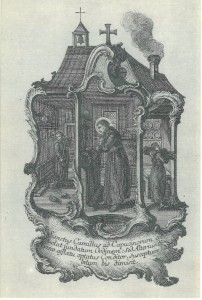 We know from Cicatelli about the esteem that Camillus had felt for this Order ever since he was a young man. The first encounter he had with it remained of fundamental importance: ‘In the city of Fermo (while he was resting there) he saw, by the will of God, pass two friars with clogs of St. Francis of Assisi who went about the city humbly and following their vows. From that visit he received at that time such a good example, that feeling compunction for his dissolute life, helped by the Lord he proposed to change it for the better. Indeed, this feeling was so strong in him that at that very moment he vowed to make himself a religious of that holy Order’.
We know from Cicatelli about the esteem that Camillus had felt for this Order ever since he was a young man. The first encounter he had with it remained of fundamental importance: ‘In the city of Fermo (while he was resting there) he saw, by the will of God, pass two friars with clogs of St. Francis of Assisi who went about the city humbly and following their vows. From that visit he received at that time such a good example, that feeling compunction for his dissolute life, helped by the Lord he proposed to change it for the better. Indeed, this feeling was so strong in him that at that very moment he vowed to make himself a religious of that holy Order’.
He then went to his uncle, Fra Paolo Lauretano, convinced that he would be immediately received into that religious house, ‘but his uncle, in part because he saw him so unwell, in part also because he seemed to him not to be inspired by God, but rather with a certain kind of desperation, did not want to give him the habit. Camillus took this as an opportunity to distance himself then from that holy intention’ (Cicatelli, p. 40).
During the first part of his life, Camillus – despite various attempts – did not manage to become a Capuchin religious because he was always forced to go to the Hospital of St. James in Rome to have his wound treated. It was precisely on one of these occasions that Camillus ‘repeated: given that God did not want me to be a Capuchin nor in that state of penitence, where I so wished to be and to die, it is a sign therefore that he wants me here in service to these poor people his sick’ (ibidem, p. 50).
Although what we have highlighted is relevant in understanding the life of Camillus, we can nonetheless identify another source of his spirituality. There is a manuscript in the general archives (AGMI, 2519) of the Camillian Order whose title can be immediately misleading (Indulgentiae concesae nostrae Religioni; presumably from 1604-1609). In reality, in addition to this subject, this manuscript also bears notes of Fr. Pelliccioni for the formation of novices. Without entering into details, we may here refer the reader to the study of Vittorio Ottazzi (‘San Bonaventura e noi. Rilievi storici’, in Domesticum 49, 1953), it must be said that the Master of Novices took advantage of the teaching of Bonaventure to translate into terms connected with the charism of Camillus the teachings of the religious formation of the Capuchins. Pelliccioni reproduces in the first part of the manuscript the translation of an ascetic booklet by St. Bonaventure with the title ‘Disciplina a novitii, cavata dal serafico Dottor S. Bona Ventura’ (‘Discipline for novices, taken from the Seraphic Doctor St. Bonaventure’).
There are, however, variants of the texts to include given that ‘Pellicioni in a decided way wanted and engaged in an adaptation of the doctrine of Bonaventure to the special needs of our vocation and the practice and method of nursing care of that time’ (V. Ottazzi, p. 36).
A further indication of the esteem that Camillus felt for Capuchin spirituality, which in a particular way concerns charity, is offered to us by Father G. B. Rossi SJ. In 1644 this author published a work on St. Bonaventure that was divided into four parts (Opuscula spiritualia honori S. Bonaventurae velificantis animi, Romae 1644), in the last of which he describes the life of Camillus in order to assert, without any contradiction, an intimate relationship between the teachings of St. Bonaventure and the holiness of Camillus which arose, grew and matured in love for the sick. Rossi states this explicitly in his preface where it is said that Camillus learnt love for the sick during the time that he stayed with the Capuchins.
What gives theological-ascetic value to charity towards the sick is a statement attributed to St. Bonaventure in the work Stimulus divini amoris in which we read: ‘he must be moved by maternal affection, so as to demonstrate compassion like a mother – for her favourite sick only child – and although towards everyone he must have an approach of care and service and must behave in a maternal way, nonetheless he must see all the others parents and masters’ (cf. Stimulus divini amoris, apud V. Sabbium, Brixiae, 1599).
Remembering, however, that what had been said by the Lord could not be forgotten by Camillus, who nurtured a special ‘devotion’ for a part of that 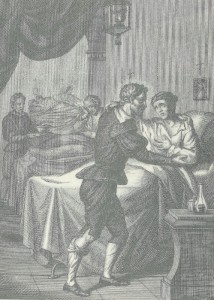 ‘good news’ proclaimed for us in the Holy Gospel. Indeed, on 19 March 1595 Camillus wrote to the professed and novices in Naples: ‘Is not what the Lord tells us good news: Infirmus eram, et visitastis me venite benedicti Patris mei, si anco in altro logo, Quod uni ex minimis meis fecistis mihi feristi di più che con quella misura, che misuriamo il prossimo nostro saremo anche noi misurati’.
‘good news’ proclaimed for us in the Holy Gospel. Indeed, on 19 March 1595 Camillus wrote to the professed and novices in Naples: ‘Is not what the Lord tells us good news: Infirmus eram, et visitastis me venite benedicti Patris mei, si anco in altro logo, Quod uni ex minimis meis fecistis mihi feristi di più che con quella misura, che misuriamo il prossimo nostro saremo anche noi misurati’.
What St. Bonaventure said – which was certainly appreciated by Camillus – was therefore an excellent comment: ‘Thus (the soul) when he sees a sick man lying on his bed, seems to see his Christ, the celestial Spouse…Why O soul do you torment yourself the whole day looking for Christ? I will show you where you can find he whom you love. He is lying silently in the infirmary, tormented and weighed down by worries. Hurry, serve him…So let us not ask ourselves where he is because we know exactly the place: he is in the infirmary’ (cf. Stimulus amoris, Pars II, Caput VII).









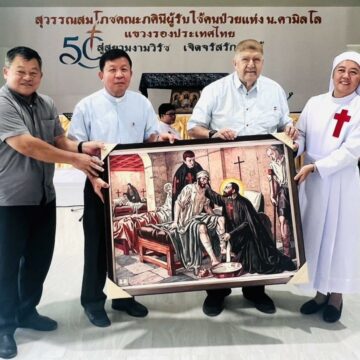
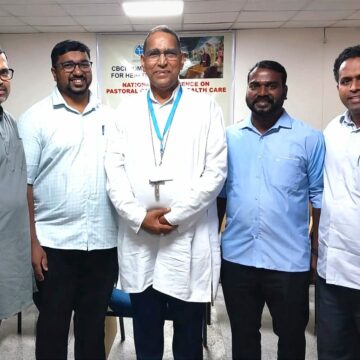


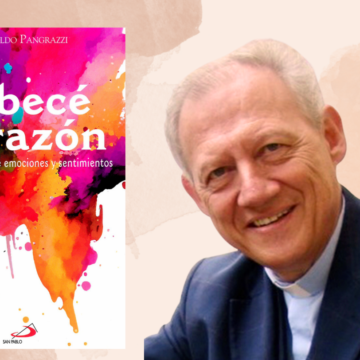
Camillians on Facebook
Camillians on Twitter
Camillians on Instagram